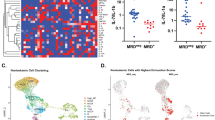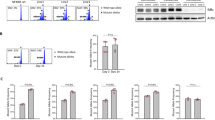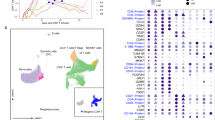Abstract
Tumor cells in chronic lymphocytic leukemia (CLL) are more prone to apoptosis when cultured ex vivo, because they lack prosurvival signals furnished in vivo via B-cell receptor (BCR)-dependent and -independent pathways. This study compared the susceptibility of unmutated (UM) and mutated (M) CLL B cells to spontaneous apoptosis and prosurvival signals. UM CLL B cells showed a significantly higher rate of spontaneous apoptosis than M CLL B cells. Nuclear factor-kB (NF-kB) was rapidly inactivated, and B-cell leukemia/lymphoma 2 (Bcl-2) expression progressively down-regulated in the UM CLL B cells. CD40-Ligand, interleukin-4 and stromal cells significantly improved their viability and partially recovered Bcl-2, but not NF-kB expression. Peripheral blood mononuclear cells also offered protection of UM CLL B cells, and recovered both NF-kB and Bcl-2 expression. T cells, rather than nurse-like cells, were responsible for protecting UM CLL B cells by means of cell-to-cell contact and soluble factors. Despite their more aggressive features, UM CLL B cells are more susceptible to spontaneous apoptosis and depend from environmental prosurvival signals. This vulnerability of UM CLL B cells can be exploited as a selective target of therapeutic interventions.
This is a preview of subscription content, access via your institution
Access options
Subscribe to this journal
Receive 12 print issues and online access
$259.00 per year
only $21.58 per issue
Buy this article
- Purchase on Springer Link
- Instant access to full article PDF
Prices may be subject to local taxes which are calculated during checkout






Similar content being viewed by others
References
Ghia P, Chiorazzi N, Stamatopoulos K . Microenvironmental influences in chronic lymphocytic leukemia: the role of antigen stimulation. J Intern Med 2008; 264: 549–562.
Damle RN, Wasil T, Fais F, Ghiotto F, Valetto A, Allen SL et al. Ig V gene mutation status and CD38 expression as novel prognostic indicators in chronic lymphocytic leukemia. Blood 1999; 94: 1840–1847.
Hamblin TJ, Davis Z, Gardiner A, Oscier DG, Stevenson FK . Unmutated Ig V(H) genes are associated with a more aggressive form of chronic lymphocytic leukemia. Blood 1999; 94: 1848–1854.
Caligaris-Cappio F, Ghia P . Novel insights in chronic lymphocytic leukemia: are we coming closer to understanding the pathogenesis of the disease? J Clin Oncol 2008; 26: 4497–4503.
Lagneaux L, Delforge A, Bron D, De Bruyn C, Stryckmans P . Chronic lymphocytic leukemic B cells but not normal B cells are rescued from apoptosis by contact with normal bone marrow stromal cells. Blood 1998; 91: 2387–2396.
Panayiotidis P, Jones D, Ganeshaguru K, Foroni L, Hoffbrand AV . Human bone marrow stromal cells prevent apoptosis and support the survival of chronic lymphocytic leukemia cells in vitro. Br J Haematol 1996; 92: 97–103.
Burger JA, Kipps TJ . CXCR4: a key receptor in the crosstalk between tumor cells and their microenvironment. Blood 2006; 107: 1761–1767.
Kurtova AV, Balakrishnan K, Chen R, Ding W, Schnabl S, Quiroga MP et al. Diverse marrow stromal cells protect CLL B cells from spontaneous and drug-induced apoptosis: development of a reliable and reproducible system to assess stromal cell adhesion-mediated drug resistance. Blood 2009; 114: 4441–4450.
Ghia P, Circosta P, Scielzo C, Vallario A, Camporeale A, Granziero L et al. Differential effects on CLL cell survival exerted by different microenvironmental elements. Curr Top Microbiol Immunol 2005; 294: 135–145.
Burger JA, Tsukada N, Burger M, Zvaifler NJ, Dell’Aquila M, Kipps TJ . Blood-derived nurse-like cells protect chronic lymphocytic leukemia B cells from spontaneous apoptosis through stromal cell-derived factor-1. Blood 2000; 96: 2655–2663.
Tsukada N, Burger JA, Zvaifler NJ, Kipps TJ . Distinctive features of ‘nurselike’ cells that differentiate in the context of chronic lymphocytic leukemia. Blood 2002; 99: 1030–1037.
Burger JA, Ghia P, Rosenwald A, Caligaris-Cappio F . The microenvironment in mature B-cell malignancies: a target for new treatment strategies. Blood 2009; 114: 3367–3375.
Ranheim EA, Kipps TJ . Activated T cells induce expression of B7/BB1 on normal or leukemic B cells through a CD40-dependent signal. J Exp Med 1993; 177: 925–935.
Haiat S, Billard C, Quiney C, Ajchenbaum-Cymbalista F, Kolb JP . Role of BAFF and APRIL in human B-cell chronic lymphocytic leukemia. Immunology 2006; 118: 281–292.
Zaninoni A, Imperiali FG, Pasquini C, Zanella A, Barcellini W . Cytokine modulation of nuclear factor-kappaB activity in B-chronic lymphocytic leukemia. Exp Hematol 2003; 31: 185–190.
Hewamana S, Lin TT, Rowntree C, Karunanithi K, Pratt G, Hills R et al. Rel a is an independent biomarker of clinical outcome in chronic lymphocytic leukemia. J Clin Oncol 2009; 27: 763–769.
Furman RR, Asgary Z, Mascarenhas JO, Liou HC, Schattner EJ . Modulation of NF-kappa B activity and apoptosis in chronic lymphocytic leukemia B cells. J Immunol 2000; 164: 2200–2206.
Packham G, Stevenson FK . Bodyguards and assassins: Bcl-2 family proteins and apoptosis control in chronic lymphocytic leukemia. Immunology 2005; 114: 441–449.
Ricca I, Rocci A, Drandi D, Francese R, Compagno M, Lobetti Bodoni C et al. Telomere length identifies two different prognostic subgroups among VH-unmutated B-cell chronic lymphocytic leukemia patients. Leukemia 2007; 21: 697–705.
de Oliveira Pinto LM, Garcia S, Lecoeur H, Rapp C, Gougeon ML . Increased sensitivity of T lymphocytes to tumor necrosis factor receptor 1 (TNFR1)- and TNFR2-mediated apoptosis in HIV infection: relation to expression of Bcl-2 and active caspase-8 and caspase-3. Blood 2002; 99: 1666–1675.
Riganti C, Orecchia S, Pescarmona G, Betta PG, Ghigo D, Bosia A . Statins revert doxorubicin resistance via nitric oxide in malignant mesothelioma. Int J Cancer 2006; 119: 17–27.
Fahey JV, Schaefer TM, Channon JY, Wira CR . Secretion of cytokines and chemokines by polarized human epithelial cells from the female reproductive tract. Hum Reprod 2005; 20: 1439–1446.
Petlickovski A, Laurenti L, Li X, Marietti S, Chiusolo P, Sica S et al. Sustained signaling through the B-cell receptor induces Mcl-1 and promotes survival of chronic lymphocytic leukemia B cells. Blood 2005; 105: 4820–4827.
Hewamana S, Alghazal S, Lin TT, Clement M, Jenkins C, Guzman ML et al. The NF-kappaB subunit Rel A is associated with in vitro survival and clinical disease progression in chronic lymphocytic leukemia and represents a promising therapeutic target. Blood 2008; 111: 4681–4689.
Bonizzi G, Karin M . The two NF-κB activation pathways and their role in innate and adaptive immunity. Trends Immunol 2004; 25: 280–288.
Vallabhapurapu S, Karin M . Regulation and function of NF-kappaB transcription factors in the immune system. Annu Rev Immunol 2009; 27: 693–733.
Senftleben U, Cao Y, Xiao G, Greten FR, Krähn G, Bonizzi G et al. Activation by IKKα of a second, evolutionary conserved, NF-κB signaling pathway. Science 2001; 293: 1495–1499.
Yilmaz ZB, Weih DS, Sivakumar V, Weih F . RelB is required for Peyer's patch development: differential regulation of p52-RelB by lymphotoxin and TNF. EMBO J 2003; 22: 121–130.
Coope HJ, Atkinson PG, Huhse B, Belich M, Janzen J, Holman MJ et al. CD40 regulates the processing of NF-κB2 p100 to p 52. EMBO J 2002; 21: 5375–5385.
Claudio E, Brown K, Park S, Wang H, Siebenlist U . BAFF-induced NEMO-independent processing of NF-κB2 in maturing B cells. Nat Immunol 2002; 3: 958–965.
Dancescu M, Rubio-Trujillo M, Biron G, Bron D, Delespesse G, Sarfati M . Interleukin 4 protects chronic lymphocytic leukemic B cells from death by apoptosis and upregulates Bcl-2 expression. J Exp Med 1992; 176: 1319–1326.
Deaglio S, Vaisitti T, Aydin S, Bergui L, D’Arena G, Bonello L et al. CD38 and ZAP-70 are functionally linked and mark CLL B cells with high migratory potential. Blood 2007; 110: 4012–4021.
Burger M, Hartmann T, Krome M, Rawluk J, Tamamura H, Fujii N et al. Small peptide inhibitors of the CXCR4 chemokine receptor (CD184) antagonize the activation, migration, and antiapoptotic responses of CXCL12 in chronic lymphocytic leukemia B cells. Blood 2005; 106: 1824–1830.
Hegde GV, Peterson KJ, Emanuel K, Mittal AK, Joshi AD, Dickinson JD et al. Hedgehog-induced survival of B-cell chronic lymphocytic leukemia cells in a stromal cell microenvironment: a potential new therapeutic target. Mol Cancer Res 2008; 6: 1928–1936.
Nishio M, Endo T, Tsukada N, Ohata J, Kitada S, Reed JC et al. Nurselike cells express BAFF and APRIL, which can promote survival of chronic lymphocytic leukemia cells via a paracrine pathway distinct from that of SDF-1alpha. Blood 2005; 106: 1012–1020.
Burger JA, Ghia P, Rosenwald A, Caligaris-Cappio F . The microenvironment in mature B-cell malignancies: a target for new treatment strategies. Blood 2009; 114: 3367–3375.
Rezvany MR, Jeddi-Tehrani M, Wigzell H, Osterborg A, Mellstedt H . Leukemia-associated monoclonal and oligoclonal TCR-BV use in patients with B-cell chronic lymphocytic leukemia. Blood 2003; 101: 1063–1070.
Chiorazzi N, Rai KR, Ferrarini M . Chronic lymphocytic leukemia. N Engl J Med 2005; 352: 804–815.
Röth A, de Beer D, Nückel H, Sellmann L, Dührsen U, Dürig J et al. Significantly shorter telomeres in T-cells of patients with ZAP-70+/CD38+ chronic lymphocytic leukemia. Br J Haematol 2008; 143: 383–386.
Tinhofer I, Weiss L, Gassner F, Rubenzer G, Holler C, Greil R . Difference in the relative distribution of CD4+ T-cell subsets in B-CLL with mutated and unmutated immunoglobulin (Ig) VH genes: implication for the course of disease. J Immunother 2009; 32: 302–309.
Gorgun G, Holderried TA, Zahrieh D, Neuberg D, Gribben JG . Chronic lymphocytic leukemia cells induce changes in gene expression of CD4 and CD8T cells. J Clin Invest 2005; 115: 1797–1805.
Bojarska-Junak A, Rolinski J, Wasik-Szczepaneko E, Kaluzny Z, Dmoszynska A . Intracellular tumor necrosis factor production by T- and B-cells in B-cell chronic lymphocytic leukemia. Haematologica 2002; 87: 490–499.
Ho CL, Hsu LF, Phyliky RL, Li CY . Autocrine expression of platelet-derived growth factor B in B cell chronic lymphocytic leukemia. Acta Haematol 2005; 114: 133–140.
Francia di Celle P, Mariani S, Riera L, Stacchini A, Reato G, Foa R . Interleukin-8 induces the accumulation of B-cell chronic lymphocytic leukemia cells by prolonging survival in an autocrine fashion. Blood 1996; 87: 4382–4389.
Mitsiades CS, Mitsiades N, Koutsilieris M . The Akt pathway: molecular targets for anti-cancer drug development. Curr Cancer Drug Targets 2004; 4: 235–256.
Manna SK, Ramesh GT . Interleukin-8 induces nuclear transcription factor-kappaB through a TRAF6-dependent pathway. J Biol Chem 2005; 280: 7010–7021.
Lanham S, Hamblin T, Oscier D, Ibbotson R, Stevenson F, Packham G . Differential signaling via surface IgM is associated with VH gene mutational status and CD38 expression in chronic lymphocytic leukemia. Blood 2003; 101: 1087–1093.
Hewamana S, Lin TT, Jenkins C, Burnett AK, Jordan CT, Fegan C et al. The novel nuclear factor-kappaB inhibitor LC-1 is equipotent in poor prognostic subsets of chronic lymphocytic leukemia and shows strong synergy with fludarabine. Clin Cancer Res 2008; 14: 8102–8111.
Acknowledgements
This work was supported by Regione Piemonte (Ricerca Sanitaria, Ricerca Scientifica e Progetto Strategico ImmOnc), MIUR (Roma, Italy), Compagnia San Paolo di Torino (Torino, Italy), Fondazione Neoplasie Sangue Onlus (Torino, Italy), Fondazione CRT, Associazione per lo Studio e la Cura delle Malattie del Sangue (Torino, Italy), and the Italian Association for Cancer Research (AIRC).
Author information
Authors and Affiliations
Corresponding author
Ethics declarations
Competing interests
The authors declare no conflict of interest.
Additional information
Supplementary Information accompanies the paper on the Leukemia website
Supplementary information
Rights and permissions
About this article
Cite this article
Coscia, M., Pantaleoni, F., Riganti, C. et al. IGHV unmutated CLL B cells are more prone to spontaneous apoptosis and subject to environmental prosurvival signals than mutated CLL B cells. Leukemia 25, 828–837 (2011). https://doi.org/10.1038/leu.2011.12
Received:
Revised:
Accepted:
Published:
Issue Date:
DOI: https://doi.org/10.1038/leu.2011.12
Keywords
This article is cited by
-
Anti-tumor activity of selinexor in combination with antineoplastic agents in chronic lymphocytic leukemia
Scientific Reports (2023)
-
Assessing technical and biological variation in SWATH-MS-based proteomic analysis of chronic lymphocytic leukaemia cells
Scientific Reports (2021)
-
Depletion of CLL-associated patrolling monocytes and macrophages controls disease development and repairs immune dysfunction in vivo
Leukemia (2016)
-
ID helix-loop-helix proteins as determinants of cell survival in B-cell chronic lymphocytic leukemia cells in vitro
Molecular Cancer (2015)
-
Basal Ca2+ signaling is particularly increased in mutated chronic lymphocytic leukemia
Leukemia (2015)



